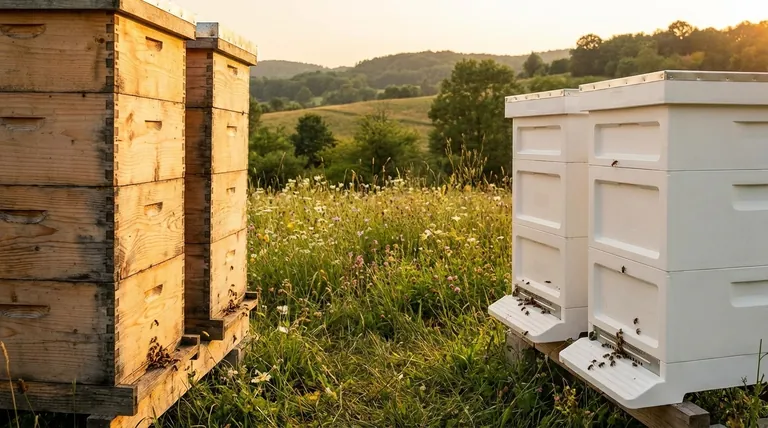The primary consideration when choosing between wood and plastic bee hives is your personal beekeeping philosophy and operational goals. There is no single "best" material; the right choice depends on whether you prioritize natural tradition and hobbyist engagement or commercial-scale efficiency and durability. The health of your bee colony remains the paramount goal, but the equipment you choose will define your path to achieving it.
Choosing between wood and plastic hives is not about finding a superior material, but about understanding a fundamental trade-off. You are deciding between the natural, repairable tradition of wood and the durable, low-maintenance efficiency of plastic. This choice will directly impact your long-term costs, maintenance workload, and overall beekeeping experience.

The Case for Wood: Tradition and Natural Appeal
Wooden hives, typically made from pine or cedar, are the traditional standard in beekeeping for several compelling reasons.
Natural and Familiar to Bees
Wood is a natural, breathable material that bees readily accept. Its texture provides a familiar surface for them to navigate and build upon.
Favorable Cost and Environmental Profile
Generally, wooden hives have a lower initial purchase price, making them more accessible for new beekeepers. As a renewable resource, wood is also biodegradable and can be repaired or recycled at the end of its life.
Customization and Repairability
Wood is easy to work with. You can paint it any color, make modifications, and repair damaged components with basic carpentry skills, extending the life of your equipment.
The Case for Plastic: Durability and Efficiency
Plastic and high-density polystyrene hives are a modern alternative designed to solve many of the inherent challenges of wood.
Unmatched Longevity
Plastic is the clear winner for durability. It is impervious to rot, warping, and moisture damage, giving it a significantly longer lifespan than a wooden hive exposed to the elements.
Simplified Maintenance and Sanitation
The non-porous surface of plastic makes it exceptionally easy to clean and sanitize, which is a major advantage for disease prevention. It is also completely resistant to pests like wax moths that can damage wooden components.
Superior Insulation and Lighter Weight
Many modern plastic and polystyrene hives offer far better insulation than wood. This helps the colony maintain a stable internal temperature, conserving energy during both hot summers and cold winters. They are also often lighter than wood, making them easier to lift and manage.
Understanding the Trade-offs
Neither material is perfect. Acknowledging the downsides is critical to making an informed decision that you won't regret later.
The Downside of Wood: Constant Vigilance
The primary drawback of wood is its need for consistent maintenance. It must be painted or sealed to protect it from moisture and rot. Without this upkeep, wood will warp, split, and deteriorate, compromising the hive's integrity. It is also vulnerable to damage from pests.
The Downside of Plastic: Cost and Acceptance
Plastic hives typically have a higher upfront cost. While they may be more cost-effective over their long lifespan, the initial investment is greater. Furthermore, some beekeepers report that bees can be slower to draw out comb on plastic frames and foundations, though this is not a universal experience. Finally, as a non-renewable material, its end-of-life environmental impact is a consideration.
Making the Right Choice for Your Goals
Your beekeeping goals should be the deciding factor. Use these points as your guide.
- If your primary focus is natural beekeeping and a traditional aesthetic: Choose wood for its renewable properties and how easily bees adapt to it, but be prepared for a consistent maintenance schedule.
- If your primary focus is long-term durability and operational efficiency: Choose plastic for its longevity and low maintenance, which is ideal for minimizing workload, especially at a larger scale.
- If your primary focus is minimizing initial investment: Wood hives typically have a lower upfront cost, making them the most accessible option for getting started.
- If your primary focus is colony health in extreme climates: High-density plastic or polystyrene hives offer superior insulation that helps bees regulate temperature more effectively.
Ultimately, the best hive is one that keeps your bees healthy and aligns with the time, effort, and resources you are prepared to invest.
Summary Table:
| Feature | Wood Hives | Plastic Hives |
|---|---|---|
| Primary Advantage | Natural, traditional, repairable | Durable, low-maintenance, efficient |
| Best For | Hobbyists, natural beekeeping | Commercial apiaries, efficiency-focused operations |
| Maintenance Level | High (requires painting/sealing) | Low (rot and pest resistant) |
| Initial Cost | Lower | Higher |
| Longevity | Moderate (with upkeep) | High |
| Insulation | Standard | Superior (especially polystyrene) |
Ready to equip your apiary with the right hives for your goals?
At HONESTBEE, we understand that the choice between wood and plastic hives is fundamental to your operation's success. Whether you're a commercial apiary prioritizing durability and efficiency or a distributor seeking reliable equipment for your customers, we supply high-quality beekeeping supplies tailored to your needs.
Let us help you maximize colony health and operational efficiency. Contact our expert team today to discuss your specific requirements and discover how our wholesale-focused solutions can benefit your business.
Visual Guide

Related Products
- Langstroth Bee Hives Bee Keeping Box for Beginners Beekeeping
- Wholesales Dadant Size Wooden Bee Hives for Beekeeping
- Long Langstroth Style Horizontal Top Bar Hive for Wholesale
- 7 x Auto Bee Flow Hive Frames Plastic Beekeeping Hive Box Supplies
- Professional Engraved Round Hive Number Tags for Beekeeping
People Also Ask
- Why are Langstroth hives recommended for beginners? Unmatched Support & Standardization
- What is the best type of bee hive for beginners? Start with the Proven Langstroth Standard
- Why might a beginner be advised to start with a Langstroth hive? Unlock a Supportive Beekeeping Ecosystem
- What basic equipment is needed to start beekeeping? Your Essential Guide to a Confident Start
- Why were wooden hives traditionally preferred? For Natural Beekeeping Aligned with Bee Biology



















